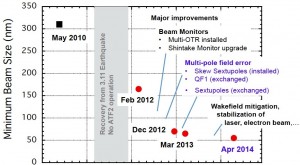The Americas Workshop on Linear Collider 2014 was held at Fermilab just before the approval of the P5 report, which contains the positive message calling for US participation in the planned International Linear Collider (ILC), should the project commence (see 22 May issue of LC NewsLine).
In the workshop, there were many presentations on technical advancements which might lead ILC to the favorable position mentioned in the P5 report. One of the examples of such presentation was “ATF2 Status & Plans” by Nobuhiro Terunuma, a scientist at KEK, Japan.
ATF2 is a final-focus test beamline which squeezes the beam of electrons to nanometre size. This is a very important technology for efficient collisions of particle beams. There are two main goals at ATF2. Goal one is to produce and confirm the small beam size, and another is to produce and confirm the stable beam.
For the goal one, the result of the beam size of 55 nanometre, the world smallest size ever, was presented.
The target beam size at the ATF is 37 nanometres. Because of the difference in the beam energy, 37 nanometre at ATF will correspond to 5 nanometres at the ILC, the specification for the ILC design. After the recovery from the damage caused by the earthquake that occurred in March 2012, scientists initially succeeded to squeeze the beam down to 160 nano metres. Since then, a further reduction in beam size has been achieved at virtually every attempt.
Terunuma said there were two major contributing factors for the remarkable result. “ One of the biggest factors is that we have more control over the stabilisation of the beam orbit. The development on the study of wakefield mitigation also made a difference.” As bunches of particles fly through the accelerator pipes, electromagnetic wakes will be excited. These wakefields kick the beams, and disturb their orbit. This may deteriorate the beam quality, therefore intensive studies on wakefield mitigation are going on.
“Achieving the small beam size is of course impressive. But what impressed me even more was the demonstration that these very small beam sizes can be quickly re-established after a downtime — even over the weekend!” said Nick Walker, the global leader of accelerator design and integration group at the Linear Collider Collaboration.
In the previous experiment, squeezing the beam size usually took time, making the beam smaller to smaller gradually. It sometimes has taken months to squeeze down the beam. Now at the ATF2, the nano-size beam can be realised within a week.
“This is extremely important, since it shows that, even if it takes some time to slowly tune the beam size down (luminosity up), we can recover that point relatively quickly after a short shutdown, providing of course nothing significant changes in the accelerator,” said Walker.
ILC plans to adopt a “push-pull” scheme, switching between two detectors to allow the operation of both detectors at one interaction region, and this requires the short shutdowns to move the detectors in and out. “These results at ATF2 give us some hope that we can quickly recover the luminosity after doing a push-pull, and will not have to start from zero again, providing of course we keep temperatures stable inside the accelerator tunnel,” said Walker.
The experiment at the ATF2 is ongoing, and they are producing records of further smaller size beams. New result will be presented at the 37th International Conference on High Energy Physics (ICHEP) to be held from 2 to 7 July in Valencia, Spain.


Recent Comments